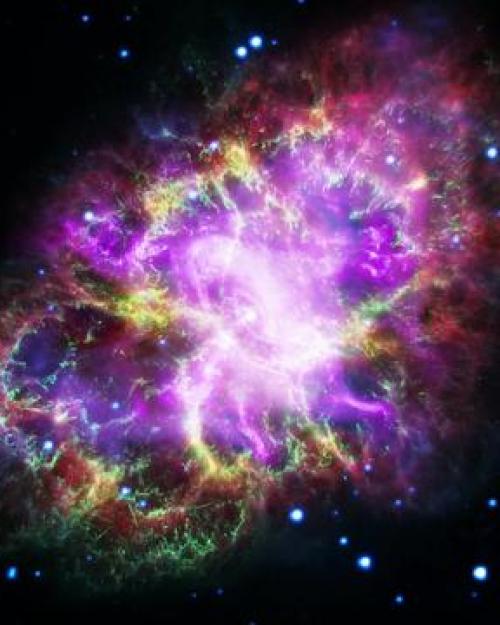The newly released “Pathways to Discovery in Astronomy and Astrophysics for the 2020s,” a decadal survey from the National Academies of Sciences, Engineering, and Medicine, identifies scientific priorities, opportunities, and funding recommendations for the next ten years of astronomy and astrophysics.
A quarter of the faculty from the Department of Astronomy in the College of Arts and Sciences participated in the survey: Nikole Lewis, assistant professor and deputy director of the Carl Sagan Institute; Gordon Stacey, Ph.D. ’85, professor of astronomy; Martha Haynes, the Goldwin Smith Professor of Astronomy; and Britney Schmidt, associate professor of astronomy and of Earth and Atmospheric Sciences in the College of Engineering.
Lisa Kaltenegger, associate professor of astronomy and director of the Carl Sagan Institute and Dmitry Savransky, associate professor of astronomy and of engineering (College of Engineering), served as reviewers for the decadal survey.
“The priorities set forth in the Astro2020 decadal directly address the most important scientific questions astronomy can answer,” said Jonathan Lunine, the David C. Duncan Professor in the Physical Sciences and chair of the Department of Astronomy. “How did everything begin? What is the nature of space itself, and how can we explore it through the effects of the most massive and exotic objects in the cosmos? How do planets form and evolve toward places that can host life, and how many such places in the Galaxy are there?”
Over the past decade Cornell has expanded its traditional strength in solar system exploration to exoplanet discovery, characterization and modeling. The Department of Astronomy is well positioned to play a role in the “Pathways to Habitable Worlds” science theme, said Lewis, through flagship-scale missions like the James Webb Space Telescope, as well as ground-based experimental and theoretical studies of exoplanets.
“In part through Cornell-led observation, theory and experiment, the capabilities of the next generation of exoplanet missions envisioned by Astro2020 will be defined and realized,” she said.
Cornell also has expanded its scientific programs in cosmology and multi-messenger astronomy and has “vigorous ongoing activities that are directly related to the highest priority activities called out by the decadal report, and in developing the next generation technologies and instrumentation that are necessary to support these future groundbreaking efforts in cosmology,” said Stacey.
One such priority is the joint NSF-DOE program for the next generation cosmic microwave background experiment (CMB-S4). Haynes noted that studies of the cosmic microwave background are already a cornerstone of the surveys planned for the Fred Young Submillimeter Telescope (FYST), centerpiece of the CCAT-Prime international project led by Cornell, which is scheduled for first light in 2024.
“The CCAT/FYST collaboration has a memorandum of understanding with the CMB-S4 to explore incorporating FYST into the CMB-S4 program,” said Haynes, adding that “the FYST’s exceptional high-altitude location and precise surface will make it a unique contributor to the CMB-S4 program through observations at the short submillimeter wavelengths.”
The report also emphasizes the power of using pulsar timing to investigate fundamental physics and astrophysics in a comprehensive program of multi-messenger astronomy.
“Pulsar timing capabilities are critical for tackling a number of high-priority science questions: the mass and spin distributions for neutron stars and black holes, the growth of supermassive black holes, the synthesis of information from electromagnetic, particle, and gravitational wave signals the properties of dark matter; pulsar timing arrays can potentially detect anomalies owing to lensing by dark matter lumps), and the cosmological implications of gravitational waves,” said James Cordes, the George Feldstein Professor of Astronomy.
Cornell is a co-PI institution for the North American Nanohertz Observatory for Gravitational Waves (NANOGrav), which is the global leader in the use of pulsars for gravitational wave detection. NANOGrav and Cornell are part of the concept development for a transformational radio array telescope in partnership with Caltech that would take the next step in pulsar timing efforts to detect gravitational waves.
The Astro2020 report also has a strong focus on building an astronomy and astrophysics workforce that is diverse, inclusive, and equitable. This is the first decadal survey to have a distinct panel dedicated to this topic, noted Haynes, who served on the panel.
“This new recognition of the foundational nature of investment in human resources is evident in the whole structure of the report,” said Haynes. “The report recognizes the demonstrated increase in innovation that a diverse community brings to the research enterprise and proposes specific steps that the agencies can take towards increasing diversity, equity and sustainability.”
Cornell’s Department of Astronomy is part of this national effort, noted Lunine, through the hiring of diverse faculty, postdoctoral scholars and research scientists, focused training for faculty, staff and students in combatting implicit and explicit bias, and active discussion of both the tools for DEI and the obstacles that continue to challenge our goals in this arena.
“I’m excited to see that there is a strong focus on building an astronomy and astrophysics workforce that is diverse, inclusive, and equitable in the report,” said Lewis. “It was really an honor to be able to serve on one of the panels that helped to shape the recommendations from the ASTRO2020 decadal survey. There were so many great ideas submitted for consideration by the community from white papers and other sources. I am looking forward to seeing how the exoplanet field evolves as we work toward the report’s goals.”
The decadal study — undertaken by the Decadal Survey on Astronomy and Astrophysics 2020 (Astro2020) Steering Committee — was sponsored by NASA, National Science Foundation, the U.S. Department of Energy, and U.S. Air Force.




